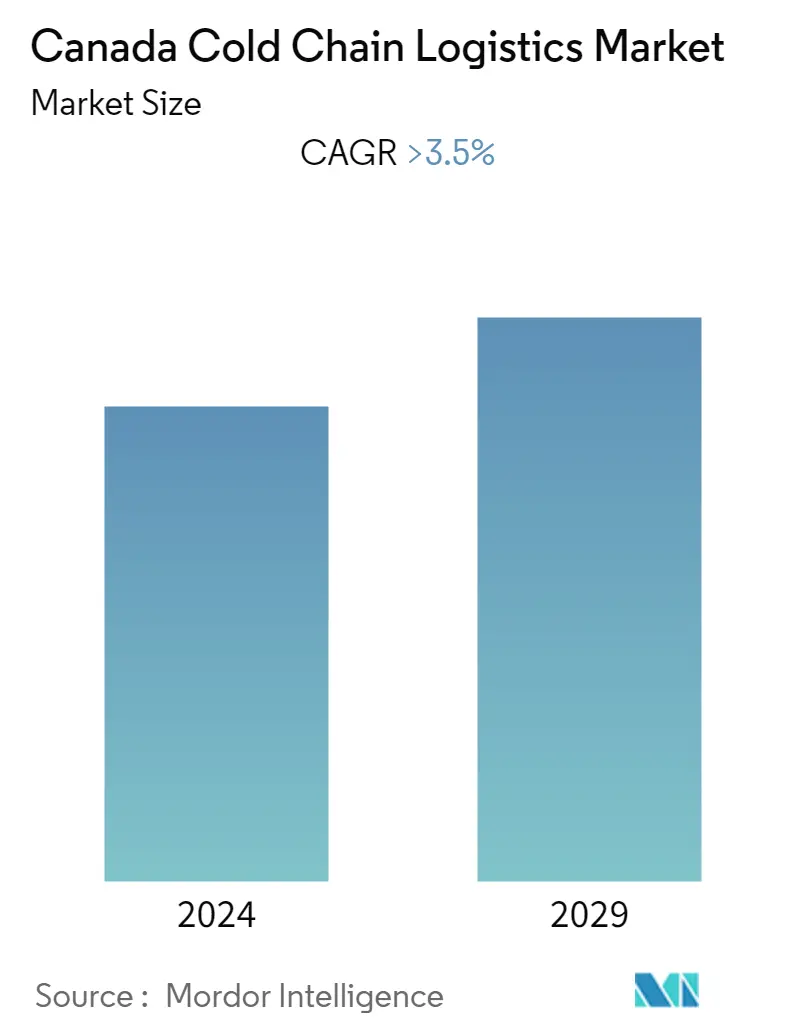Market Size of Canada Cold Chain Logistics Industry

| Study Period | 2024 - 2029 |
| Base Year For Estimation | 2023 |
| Forecast Data Period | 2024 - 2029 |
| CAGR | > 3.50 % |
| Market Concentration | High |
Major Players
*Disclaimer: Major Players sorted in no particular order |
Need a report that reflects how COVID-19 has impacted this market and its growth?
Canada Cold Chain Logistics Market Analysis
The Canada Cold Chain Logistics market is valued at about USD 6.20 billion in the current year and is expected to grow at a CAGR of more than 3.5% during the forecast period.
- Crossborder supply chains are critical to the Canadian food sector, with significant volumes of food and agricultural products moving across the Canadian-U.S. border daily. The United States accounts for over 50% of the value of all Canadian agriculture and agrifood exports and around 60% of the value of Canadian food imports. The United States is a net importer of Canadian beef and cattle, Canada relies heavily on seasonal imports of fresh produce from the United States and Mexico. Cold chain logistics were important for a majority of the imports and exports as the products were perishable goods. The United States imports fresh produce worth over USD 22 billion yearly from over 125 different nations, while Mexico and Canada account for 77% and 11%, respectively, of the total fresh fruit and vegetable imports. It is critical to transport fresh produce effectively because their shelf lives are finite.
- The FSCC (food supply cold chain) is not dispersed fairly throughout the world. Ie. Canada has a strong FSCC that can maintain the proper temperature for all perishable food wherever it is needed. Despite this, it is known that the FSCC sometimes have interruptions or breaks. In Canada, 5% of avoidable food losses happen during distribution, 12% happen at the retail level, and 21% happen at the consumer level. It is thought that one of the main causes of these losses is inadequate temperature maintenance throughout the FSCC. The distance that food travels across Canada poses a significant problem for maintaining temperature. With a sizable population centred in urban regions dispersed across the nation and more communities dispersed throughout sizable rural and remote areas, Canada has a vast landmass. Road transportation is the main method used to deliver food to urban areas, whereas air transportation is used to transport food to remote places, particularly Northern villages.
- A significant global advantage for Canada lies in its numerous water ports. Ocean ports on the Pacific and Atlantic coasts open the Asian and European markets, respectively. In addition, the St. Lawrence Seaway provides expanded port service to several Canadian and U.S. locations in the Great Lakes. The Great Lakes offer outstanding intermodal logistics services to the central provinces of Canada and to the United States. Canada has distinct logistical capabilities that can be leveraged. For importing and exporting, Canada is a leader in port availability, infrastructure, and accessibility. Location, natural assets, and logistics support have created an environment to provide product distribution to global locations.
- Canada is a major exporter of fresh, chilled, and frozen meat, especially bovine products, and pork, as well as seafood products. Canada imports most of its fruits and vegetables because local production is relatively limited given the country's cold climate. The state (chilled or frozen) of imports and exports is specific to the food product. Most bovine products and salmon products that are imported and exported are fresh or chilled, while most pork imports, crab exports and lobster exports are frozen.
